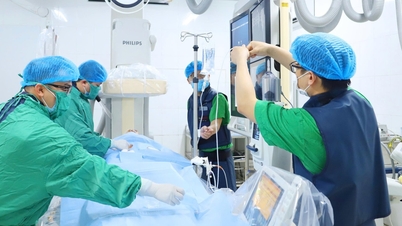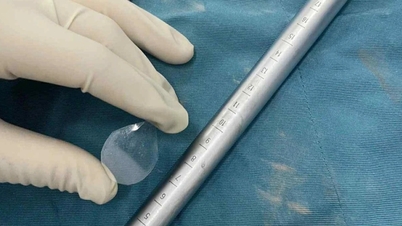Ho Chi Minh City After giving birth to 5 children, Ms. Tuat had an IUD inserted. 44 years later, the IUD penetrated the uterine muscle, causing a risk of infection.
Mrs. Pham Thi Tuat, now 80 years old, recently had frequent urination and abnormal vaginal bleeding. An ultrasound at Tam Anh General Hospital in Ho Chi Minh City discovered that the IUD had penetrated the uterine muscle.
On August 18, Dr. Lam Hoang Duy, Obstetrics and Gynecology Center, said that Ms. Tuat's IUD was made of soft plastic, with a pyramid-shaped structure like a Christmas tree. This is a type of IUD that has been around for a long time and is no longer used.
Ms. Tuat said she had an IUD inserted after giving birth to 5 children and then forgot about it and did not go to the hospital to have it removed.
According to Dr. Duy, an IUD left in for too long is like a foreign object in the uterus. An expired IUD can easily become dislodged, broken, penetrate the abdominal cavity, adhere to nearby organs, and can lead to uterine perforation, peritonitis, or bleeding. In some rare cases, the IUD gets lost in the pelvic organs.
Like the old lady above, the long-term IUD has stuck to the uterine wall, while she has been postmenopausal for a long time, the uterus has shrunk so surgery is needed to remove the IUD. However, the patient is old, has high blood pressure, diabetes, and is afraid of complications when removing the IUD surgically.
The anesthetists removed the IUD for the patient through the vagina, combined with a uterine biopsy to screen for cancer. Normally, the procedure to remove the IUD on time is very simple, taking only 10 minutes. As for Mrs. Tuat, because her uterus was atrophied, removing the IUD was more difficult, and there were many risks of complications such as uterine perforation. The ultrasound doctor in the operating room assisted the obstetrician in finding and safely removing the IUD. A day later, she was healthy and discharged from the hospital.

The doctor asked about Mrs. Tuat's health after removing the IUD. Photo: Tue Diem
Mrs. Tuat is the oldest case of IUD forgotten for the longest time that Dr. Duy has ever seen. Tam Anh Hospital has received many cases of IUDs that have expired for 20-30 years but have not been removed, causing complications such as uterine perforation, intestinal perforation, and bladder stones.
According to Dr. Duy, complications after IUD placement are rare but can be serious due to uterine perforation (rate of 1.3-1.6 cases per 1,000 placements). The IUD can also penetrate the uterus and fall into the abdomen, bladder, colon, small intestine... causing damage, infection, peritonitis or internal bleeding, even death.
Many cases of IUD ectopic pregnancy do not cause symptoms. In cases where symptoms do occur, they can include mild abdominal pain, vaginal bleeding, infertility, fever, diarrhea, or gastrointestinal bleeding. Some people may experience intestinal obstruction or necrosis. Dr. Duy said that exploratory laparoscopy is the first treatment method, with a high success rate, possibly up to 100%.
Both IUDs and implants have an expiration date. IUDs last 5-10 years, implants last 3-5 years. Women with implants who cannot feel the implant on their arm should see a doctor immediately.
Tue Diem
Readers can ask questions about gynecological diseases, pregnancy health and women's physiology here to get answers from doctors.
Source link



![[Photo] Keep your warehouse safe in all situations](https://vphoto.vietnam.vn/thumb/1200x675/vietnam/resource/IMAGE/2025/10/1/3eb4eceafe68497989865e7faa4e4d0e)
![[Photo] President of the Cuban National Assembly visits President Ho Chi Minh's Mausoleum](https://vphoto.vietnam.vn/thumb/1200x675/vietnam/resource/IMAGE/2025/10/1/39f1142310fc4dae9e3de4fcc9ac2ed0)


![[Photo] Hanoi morning of October 1: Prolonged flooding, people wade to work](https://vphoto.vietnam.vn/thumb/1200x675/vietnam/resource/IMAGE/2025/10/1/189be28938e3493fa26b2938efa2059e)



























































































Comment (0)